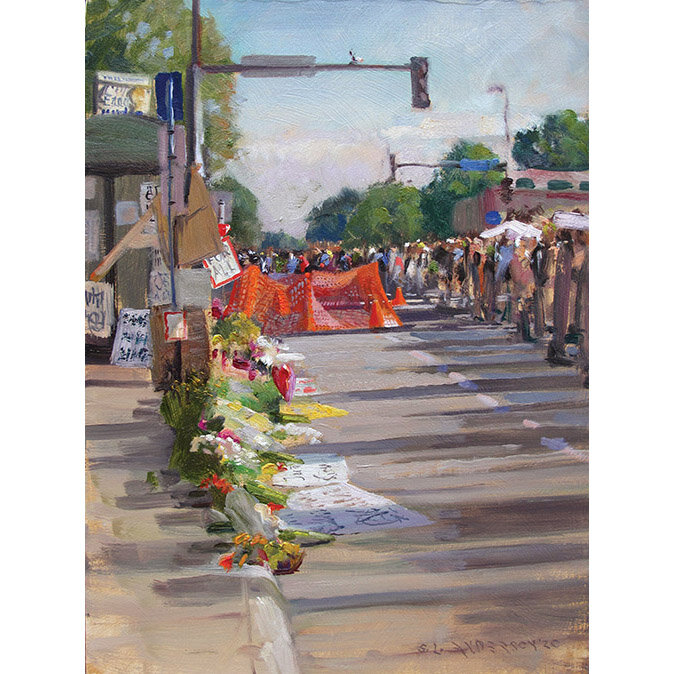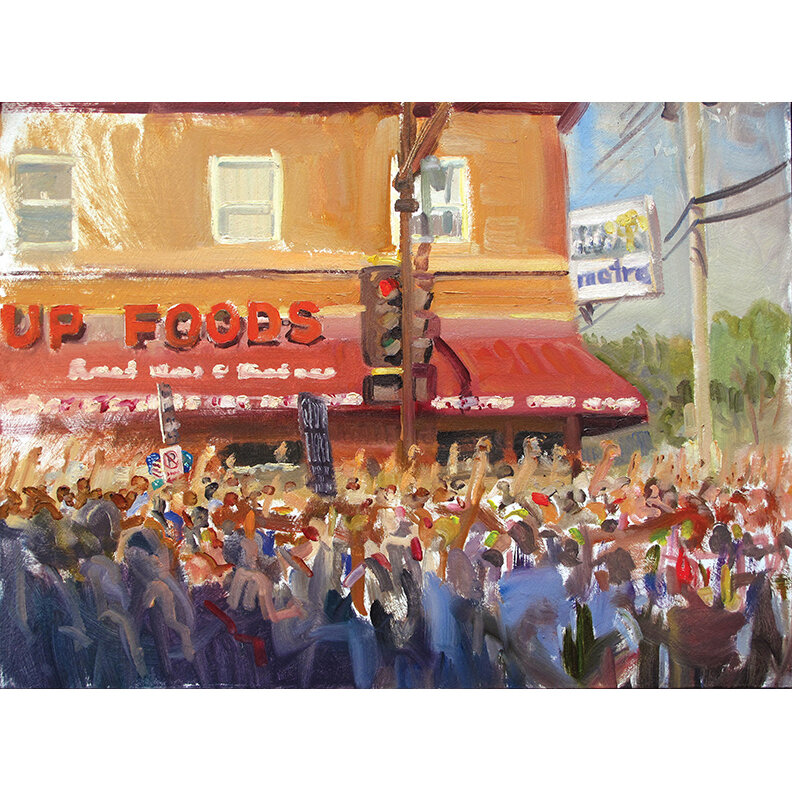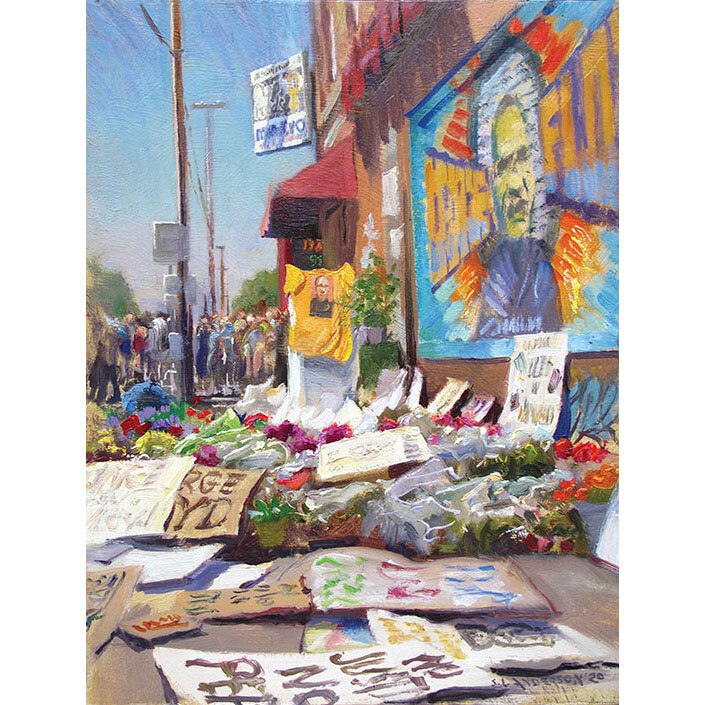Painting Amid Protest: Thoughts on Plein Air and Whiteness
During the first week of June, I spent three plein air sessions at 38th and Chicago, the site where George Floyd was murdered by Minneapolis police. The intersection had turned into a memorial to Floyd and other victims of police brutality. The area was quickly attracting international attention.
The previous weekend, while visiting there with my family, we discussed whether painting the scene would be appropriate. Like my 2007 series of paintings of the I-35W bridge reconstruction, the events related to the site were tragic and historic. I felt compelled to paint there. I’ve lived in south Minneapolis for 35 years. Painting my neighborhood is a big part of my work. But despite living less than a mile due west of Cup Foods, my life feels worlds apart from what Floyd was subjected to that day, and I don’t personally know anyone effected by police violence. Would I be perceived as a “cultural tourist”? As with many people in the community (and around the world) my emotions were high, but was what I observed of the gathering at 38th and Chicago my story to tell?
On that last point, I decided yes, I could tell a few moments of it. Like a photographer, my work is to document the world around me. (It just takes me a lot longer and I’m very conspicuous.)
My experience at 38th and Chicago was heartwarming and heartbreaking. On my first day painting there, George Floyd’s brother came to witness the site of his brother’s death and to say a few words. He and others with megaphones emotionally decried how black people and other marginalized members of society are treated by police. They vowed justice, love, power, and change. By the end of the day, my face mask was fairly drenched from my own emotions.
Despite the tragic circumstances, there was a genuine sense of community and goodwill. Many “mutual aid” tents gave away free food and household supplies. An adjacent church broadcast inspirational music. People of all colors were authentically interested in what I was doing and I never felt less than welcome.
Painting scenes on location in real time is never easy, but doing it in a crowd is tricky. The first challenge is to find a place to set up where I won’t be in the way. I don’t want anyone to trip over my easel and, ideally, I’ll have enough space to back up and take a look at what I’m doing. The first day, I wedged my easel between a bus shelter and a tall utility box. The next time, I sat directly on the sidewalk—on a 90 degree day—about seven feet from a dumpster dripping old fryer oil. For my last session, I carved out a space by shifting around a pile of refuse next to a commercial recycling bin. Near each of those spots, friendly volunteers handed out food and cool drinks to all who asked. I gave them small donations and was heartily supplied with icy bottles of water, snacks, and hotdogs.
Since these outings, my wife and business partner, Kristi, and I have read and listened to a variety of thought-provoking opinions on race, protest art, and the graffiti and murals that were painted this summer on all the plywood-covered storefronts. I don’t see my series of paintings as making an explicit statement of protest, but there’s no doubt I express something with the scenes I select. I care about this city and what happens in it and to it. I’d like to think that by painting it as it is, that comes through.
Many local artists and others have strong feelings about who has a right to “claim” certain spaces. One online forum, titled “Black Art in the Era of Protests,” was moderated by the former local newscaster Robyn Robinson, now Board Chair of the Minnesota Museum of Art, and included several local Black artists from different disciplines. An intense portion of the discussion focused on the now famous George Floyd mural on the side of the Cup Foods building, a prime surface in what had become a sacred space where pretty much everyone agrees expressions of Black grief and Black voices belong front and center. The mural was created by local artists Greta McClain, Cadex Herrera, and Xena Goldman. McClain, who is white, led the project and has been roundly criticized as swooping in far too fast and co-opting the memorial space.
The Star Tribune did a short video on the controversy. McClain grew up in the Powderhorn Park neighborhood; the memorial lies in its southwest corner. For someone in her late 20s, she has an impressive portfolio of community-centered work, and has engaged young people and volunteers of all races and ages to help create murals. She agrees she messed up at Cup Foods. In a Facebook post in early June, she expressed profound regret at how she handled the project.
All this has caused Kristi and me to think more deeply about my paintings there. Where should they hang? Should they hang? Is it wrong to profit from them? (If we sell them at all, we intend to donate the proceeds to organizations that protect and encourage Black voters. FairFight, a group led by Stacey Abrams, is one example.) On a personal level, we’ve become more aware of terms like “performative allyship”—white folks and businesses saying and posting easy stuff in support of marginalized people, but not actually taking actions that advance change, not doing anything hard. We are listening—really trying to hear what is being said—and working on being more willing to speak out and step up, even if doing so makes us or others uncomfortable.
Clearly, there are plenty of ways my whiteness has informed my art. I am the person I am: a male product of Western European, upper middle class white American culture. Beyond the art itself, the principle of “accumulated advantage” goes a long, long way in this field. The majority of my painting sales have happened through our nearly entirely white personal networks of family, friends, former coworkers, parents at our kids’ schools—and their friend and families, etc. Any honest cultural accounting will add up to one thing: a whole lotta privilege.
The plein air world today has a big diversity problem. A young member of a plein painting group, Outdoor Painters of Minnesota, Philip Alexander Carlton, recently wrote a thorough analysis of this. It’s a must read. The materials, training, and events are expensive, and as in any art form, there’s no guarantee of a steady income. But there is absolutely nothing inherently white about painting in oils, from life. If anyone reading this is, or knows of, a young Black artist (over 18) interested in learning to paint landscapes on location, we commit to providing them with the tools, paint, and training to get them started. Young people might not look at plein air as the coolest thing on the block, but it’s a great foundation for any kind of art. If I get more than a couple takers on this offer, I will drum up support from the wider plein air community.
I recently reached out to a few local artists, black and white, to ask for feedback about if and how to promote my 38th and Chicago paintings. One artist, who is black, responded that my work at the site was my own authentic experience and isn’t displacing any black artist’s work. That felt true. These conversations also helped me decide to step back from my initial impulse to “strike while the iron was hot” and seek attention for the paintings (beyond Instagram) right away. Anyone who knows me knows I love a good spotlight, especially if I’m at the center of it. I also realize that can sometimes deny light to others.
I plan to submit my painting Sacred Ground to the Minnesota State Fair juried art exhibition. The fair is canceled this year because of Covid-19, but the art show is on. According to the Fair website, “participation is open to all living residents of Minnesota, and each may submit one work for consideration.” I’m proud of my painting and I hope it gets in. I also hope it will hang in the company of the rich variety of artistic voices that exist in this state.
Update: The painting wasn’t selected for the Minnesota State Fair Fine Arts Exhibition. I’ve written about the fair in the past (see my post about getting a second place ribbon last year). Ah, the vagaries of juried art shows. Sometimes you make it sometimes you don’t!
Top photo by Spencer Bergen
Video below by Gabriela M.
Paintings below, left to right:
George Floyd’s Curb, 16 x 12” oil on panel
Sacred Ground, 38th and Chicago, Minneapolis, 18 x 24” oil on panel
George Floyd Mural and Memorials, 16 x 12” oil on panel





